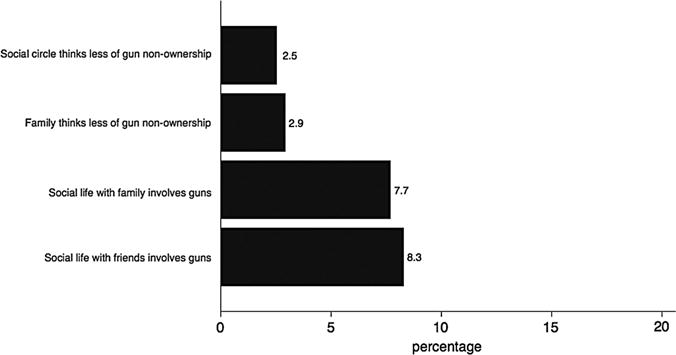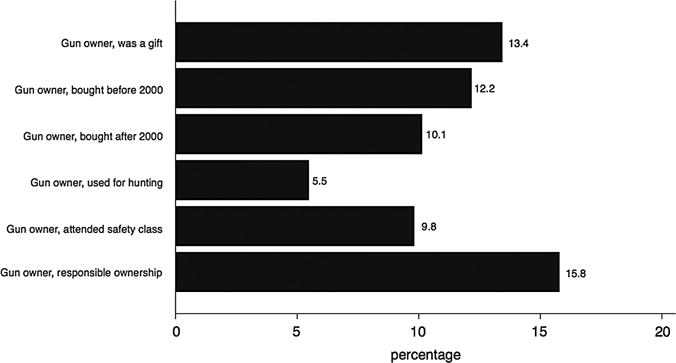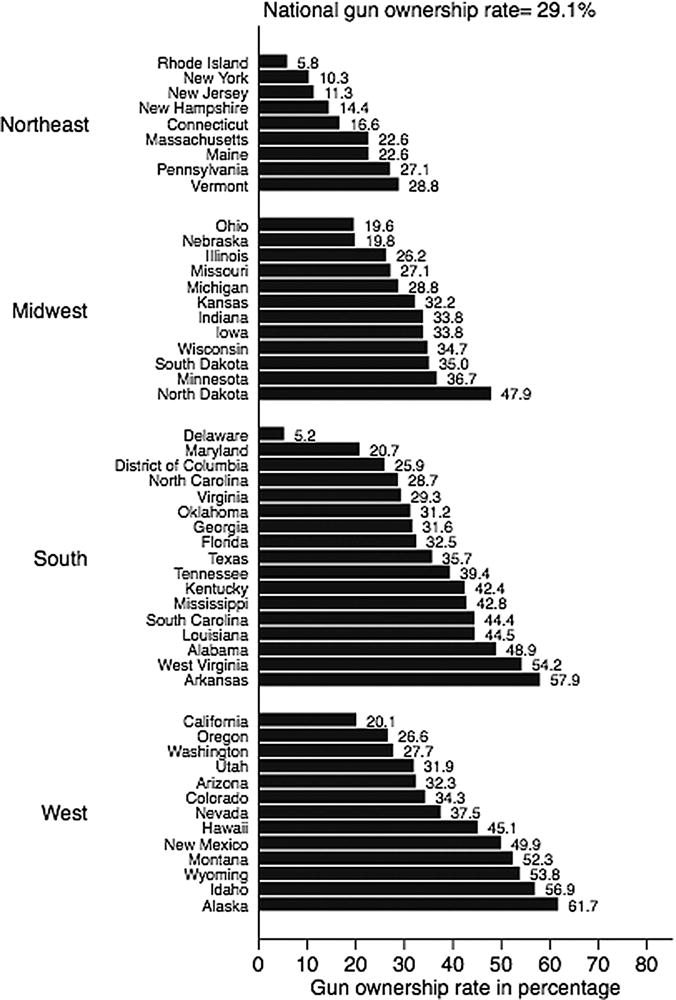Abstract
We assessed gun ownership rates in 2013 across the USA and the association between exposure to a social gun culture and gun ownership. We used data from a nationally representative sample of 4000 US adults, from 50 states and District of Columbia, aged >18 years to assess gun ownership and social gun culture performed in October 2013. State-level firearm policy information was obtained from the Brady Law Center and Injury Prevention and Control Center. One-third of Americans reported owning a gun, ranging from 5.2% in Delaware to 61.7% in Alaska. Gun ownership was 2.25-times greater among those reporting social gun culture (PR=2.25, 95% CI 2.02 to 2.52) than those who did not. In conclusion, we found strong association between social gun culture and gun ownership. Gun cultures may need to be considered for public health strategies that aim to change gun ownership in the USA.
Firearm violence in the USA continues to be a major public health concern.1 There is little question that the high prevalence of gun ownership in the USA contributes to the burden of firearm-related injury.2 Firearm ownership and use for recreation and personal defense have long been an integral part of US culture.3 Using firearm suicide as proxy, firearm ownership in the USA in 2013 was reported to be very high, with an overall national prevalence of 57.7% and ranged from a low of 25.8% in Hawaii to a high of 76.8% in Mississippi.4 The wide regional variation in gun ownership demonstrated in 2013 across US states was also seen in 2004 with prevalence ranging from 10% to 66%.5
Social norms are unseen codes of behaviour and powerful predictors of behavioural intentions and health behaviours.6 In many parts of the country, these social norms include participation in social activities around gun ownership. These social gun cultures have rarely been formally studied but may be important determinants of gun ownership. Using data from a nationally representative survey, we assessed the prevalence of gun ownership and whether exposure to social gun culture is associated with gun ownership even while taking into account individual-level and state-level drivers such as strength of state gun policies and state gun fatality rate.
METHODS
We used data from a survey by YouGov (http://www.yougov.com) among individuals aged >18 years in USA in 2013. YouGov is a nonpartisan research firm that recruits its panel online through a polling website and develops nationally representative surveys used widely for research.7 A description of YouGov is presented in online supplementary appendix I. YouGov invited 11 471 potential participants, out of which 5392 (47.0%) started the survey and eventually 4622 (40.3%) completed the survey. Using the 4622 participants, propensity score matching with 2010 American Community Survey sample with selection within strata by weighted sampling with replacements was performed to obtain a nationally representative population. Out of the 4622 respondents, 4000 were matched and identified to be nationally representative. This study was performed using the 4000 respondents who were identified as a nationally representative cohort. The survey instrument and survey methodology are explained in detail in online supplementary appendix II and III.
Social gun culture was measured using four questions that assessed whether an individual’s ‘social circle thinks less of them if they did not own a gun’, ‘family thinks less of them not owning a gun’, ‘social life with family involves guns’ and ‘social life with friends involves guns’. We defined exposure to social gun culture if one of the four questions was answered as ‘yes’. Gun ownership was measured using six questions that asked status of gun ownership such as whether being a gun owner, the gun was gifted, bought before year 2000, bought after 2000, the gun was used for hunting, have attended gun safety classes and whether the owner advocated responsible gun ownership. We categorised the individual as a gun owner if they responded ‘yes’ to any of these six questions. Individual responses were not mutually exclusive. Social gun culture and gun ownership questions are presented in online supplementary appendix II. Individual characteristics considered were age, gender, race, ethnicity, marital status, education, employment, income, language, have children, neighbourhood crime and violence exposure. State-level characteristics were strength of gun policy in the respondent’s home state using the Brady Law strength score8 and 2011 state-specific gun fatality rates.9 Covariates and classifications are explained in detail in online supplementary appendix IV.
We used survey-weighted modified Poisson regression to derive prevalence ratios (PR) and 95% CIs to assess the independent association between social gun culture and gun ownership. Correlation within states was accounted for using robust SEs. A sensitivity analysis was performed by redefining social gun culture, when the respondent reported a positive response to a minimum of two out of the four questions. STATA V.13.1 was used for analysis.
RESULTS
Of the total 4000 individuals, 101 (2.5%) reported that social circle thinks less of gun non-ownership, 117 (2.9%) reported that family thinks less of gun non-ownership, 308 (7.7%) reported social life with family involves guns and 332 (8.3%) reported that social life with friends involves guns (figure 1). A total of 528 individuals (13.7%) reported to have at least one social gun culture; 8.0% reported ‘yes’ to at least 1 out of four, 4.4%, 0.5% and 0.8% reported ‘yes’ to two, three and all four social gun culture questions.
Figure 1.

Distribution of social gun culture variables.
Gun ownership status was reported as gifted by 538 (13.4%), bought prior to year 2000 by 487 (12.2%), bought after year 2000 by 406 (10.1%), was used for hunting by 219 (5.5%), attended gun safety classes by 393 (9.8%) and to advocate responsible gun ownership by 631 (15.8%; figure 2). The prevalence of national gun ownership was 29.1% among the 4000 survey participants, varying from 5.2% in Delaware to 61.7% in Alaska (figure 3). Gun ownership was the lowest in Northeast states, while south US census-defined states had highest rates.
Figure 2.

Distribution of gun ownership status.
Figure 3.

Gun ownership rates in each state, 2013.
Exposure to social gun culture among gun owners and non-owners was 32.3% and 6.1%, respectively (p<0.0001). Social life with friends involving guns was reported by 21.7% of gun owners and 2.9% of non-owners and social life with family involving guns by 19.7% and 2.8%, respectively. Those respondents whose family thinks less of them if they do not own guns was reported by 7.5% of gun owners and 1.0% of gun non-owner and whose social circles think less of them if they do not own guns was reported by 6.7% and 0.8%, respectively (p<0.0001).
A strong association between gun ownership and being a part of a social gun culture was observed, even after adjusting for significant covariates (PR=2.25, 95% CI 2.02 to 2.52; table 1). The other individual covariates independently associated with gun ownership were age >55 years, not black, male, income > $25 K, ever married/partnered and medium/high violence exposure. Gun ownership was 31% more likely among those living in states (PR=1.31, 95% CI 1.03 to 1.67) with least stringent gun policies and 51% more likely among those living in states with high gun death rates (PR=1.51, 95% CI 1.06 to 2.13). In a sensitivity analysis, with social gun culture defined as a positive response to at least two out of the four questions regarding social gun culture, after adjusting for significant covariates the strength of association between gun ownership and social gun culture was similar to the results of the primary analysis (PR=2.20, 95% CI 1.91 to 2.52).
Table 1.
Association of individual and state characteristics with gun ownership
| Crude OR (95% CI) | p Value | MV OR (95% CI) | p Value | |
|---|---|---|---|---|
| Social gun culture | <0.0001 | <0.0001 | ||
| No | Reference | Reference | ||
| Yes | 2.98 (2.53 to 3.49) | 2.25 (2.02 to 2.52) | ||
| Age, years | <0.0001 | <0.0001 | ||
| 19–55 | Reference | Reference | ||
| >55 | 1.41 (1.28 to 1.55) | 1.22 (1.11 to 1.35) | ||
| Hispanic | <0.0001 | 0.25 | ||
| No | Reference | Reference | ||
| Yes | 0.64 (0.52 to 0.79) | 0.81 (0.57 to 1.16) | ||
| Black race | <0.0001 | <0.0001 | ||
| No | Reference | Reference | ||
| Yes | 0.48 (0.37 to 0.62) | 0.56 (0.43 to 0.72) | ||
| Gender | <0.0001 | <0.0001 | ||
| Female | Reference | Reference | ||
| Male | 1.74 (1.55 to 1.96) | 1.60 (1.41 to 1.82) | ||
| Marital status | <0.0001 | <0.0001 | ||
| Never married | Reference | Reference | ||
| Married/partner | 2.10 (1.78 to 2.47) | 1.73 (1.46 to 2.05) | ||
| Divorced/widowed/separated | 1.56 (1.28 to 1.91) | 1.50 (1.23 to 1.84) | ||
| Education | 0.44 | |||
| Less than high school | Reference | |||
| High school/GED | 1.27 (0.93 to 1.74) | |||
| Some college | 1.27 (0.95 to 1.68) | |||
| More than college | 1.27 (0.93 to 1.72) | |||
| Unemployed | 0.008 | 0.34 | ||
| No | Reference | Reference | ||
| Yes | 0.72 (0.56 to 0.92) | 0.90 (0.71 to 1.12) | ||
| Income | <0.0001 | 0.047 | ||
| <$25 000 | Reference | Reference | ||
| $25 000 to <$50 000 | 1.20 (1.00 to 1.44) | 1.08 (0.89 to 1.32) | ||
| ≥$50 000 | 1.52 (1.33 to 1.73) | 1.18 (1.02 to 1.37) | ||
| Have children | 0.66 | |||
| No | Reference | |||
| Yes | 1.03 (0.91 to 1.16) | |||
| Speaks only English | <0.0001 | 0.55 | ||
| No | Reference | Reference | ||
| Yes | 1.74 (1.28 to 2.35) | 1.16 (0.71 to 1.91) | ||
| Neighbourhood crime | 0.014 | 0.95 | ||
| Low crime | Reference | Reference | ||
| High crime | 0.83 (0.72 to 0.96) | 0.99 (0.84 to 1.17) | ||
| Violence exposure | <0.0001 | 0.045 | ||
| Low | Reference | Reference | ||
| Medium | 1.09 (0.95 to 1.25) | 1.08 (0.93 to 1.25) | ||
| High | 1.41 (1.24 to 1.60) | 1.17 (1.03 to 1.33) | ||
| Brady Law strength score | <0.0001 | 0.003 | ||
| High (≥59) | Reference | Reference | ||
| Moderate (<59 to ≥24) | 1.46 (1.13 to 1.89) | 1.23 (1.01 to 1.49) | ||
| Mild (<24 to ≥15.5) | 1.80 (1.42 to 2.28) | 1.41 (1.17 to 1.71) | ||
| Least (<15.5) | 2.11 (1.63 to 2.73) | 1.31 (1.03 to 1.67) | ||
| State gun fatality rate | <0.0001 | 0.017 | ||
| Lowest (≤7.7) | Reference | Reference | ||
| Low (>7.7 to ≤10.7) | 1.36 (0.84 to 2.20) | 1.16 (0.85 to 1.58) | ||
| Moderate (>10.7 to ≤11.6) | 1.83 (1.14 to 2.91) | 1.29 (0.93 to 1.80) | ||
| High (>11.6) | 2.26 (1.41 to 3.64) | 1.51 (1.06 to 2.13) |
Social gun culture was reporting yes to at least one of the four questions: ‘social circle thinks less of them if they did not own a gun’, ‘family thinks less of them not owning a gun’, ‘social life with family involves guns’ and ‘social life with friends involves guns’. Reference was reporting ‘no’ to all four questions.
Modified Poisson regression was using generalized estimating equations (GEE) to account for clustering by states. p Values are from weighted Poisson regression with cluster option for state. GED, General Educational Development; MV, multivariable.
DISCUSSION
We found that one-third of US residents are gun owners and gun ownership rates vary widely between states. Although there are no recent nationally representative survey results of gun ownership rates in the USA to allow for direct comparisons, the rates we report are consistent with rates from the Behavioral Risk Factor Surveillance System in 2004, where the prevalence of household firearms ranged from 10% to 66% across the 50 states.5
We showed that exposure to social gun culture was robustly associated with gun ownership and to our knowledge, this is the first study to establish empirical evidence of the relation between social gun culture and gun ownership. Prior evidence has shown an association between violent and gun-related behaviours and broad cultural norms.10 The notion that participation in a social gun culture and gun ownership co-occurs and may be mutually reinforcing readily builds on theoretical models of culture–personality relations. This inter-relationship suggests that sociocultural environments affect how people behave and how those people adopt the beliefs, values and social behaviours that are acceptable in that community culture.11 The link between social gun culture and gun ownership also suggest one avenue through which modern conceptions of the primacy of gun ownership, despite the potential public health consequences, are reinforced. Although notions of protection of one’s family and property originally justified gun ownership,12 gun ownership is today sustained in public consciousness much more through calls to constitutionally enshrined social values, reinforced intermittently by outrage at efforts to limit widespread gun availability. Insofar as social gun cultures may contribute to these prevailing social values, their co-occurrence with gun ownership suggests that social gun culture must be considered by potential public health intervention in the area.
This analysis rests on a cross-sectional design. Therefore, we cannot infer whether exposure to social gun culture predisposes one to gun ownership or whether the latter increases likelihood of participation in the former. However, this is not particularly germane to the observations being drawn here, suggesting simply that prudent gun policies that aim to reduce gun ownership and gun-related injury might need to actively consider the prevailing social gun culture in the USA. Future studies that aim to inform our understanding of gun ownership may fruitfully explore the determinants of a participation in social gun culture in the USA.
Supplementary Material
What is already known on the subject?
-
▸
Firearm violence in the USA continues to be a major public health concern.
-
▸
High prevalence of gun ownership in the USA contributes to the burden of firearm-related injury.
What this study adds?
-
▸
Exposure to social gun culture was associated with gun ownership by 2.25-fold.
-
▸
One-third of all US citizens reported gun ownership.
-
▸
Gun violence prevention policies might need to actively consider the prevailing social gun culture in the USA.
Footnotes
Additional material is published online only. To view please visit the journal online (http://dx.doi.org/10.1136/injuryprev-2015-041586).
Twitter Follow Bindu Kalesan at @MadisonsIntent
Contributors BK and SG conceptualised and designed the study. BK performed analysis. All four authors drafted, edited and finalised the manuscript.
Competing interests BK is an unpaid Vice-President of Gun Violence Survivors Foundation, a non-profit organisation and an employee of PPD. SG has received speaking fees from Universities.
Provenance and peer review Not commissioned; externally peer reviewed.
Data sharing statement We offer collaboration with researchers who would like to partner with us for future studies using these data.
References
- 1.Kalesan B, Vasan S, Mobily ME, et al. State-specific, racial and ethnic heterogeneity in trends of firearm-related fatality rates in the USA from 2000 to 2010. BMJ Open. 2014;4:e005628. doi: 10.1136/bmjopen-2014-005628. [DOI] [PMC free article] [PubMed] [Google Scholar]
- 2.Hemenway D. Private guns, public health. New. Vol. 2009 University of Michigan Press; Dec 29, 2006. [Google Scholar]
- 3.Carlson JD. States, subjects and sovereign power: Lessons from global gun cultures. Theoretical Criminology. 2014;18:335–53. [Google Scholar]
- 4.Seigel M, Ross CS, King C. The relationship between gun ownership and firearm homicide rates in the United States, 1981–2010. Am J Public Health. 2013;12:12. doi: 10.2105/AJPH.2013.301409. [DOI] [PMC free article] [PubMed] [Google Scholar]
- 5.Miller M, Barber C, White RA, et al. Firearms and suicide in the United States: is risk independent of underlying suicidal behavior? Am J Epidemiol. 2013;178:946–55. doi: 10.1093/aje/kwt197. [DOI] [PubMed] [Google Scholar]
- 6.Prochaska JO, Velicer WF. The transtheoretical model of health behavior change. Am J Health Promot. 1997;12:38–48. doi: 10.4278/0890-1171-12.1.38. [DOI] [PubMed] [Google Scholar]
- 7.Almeling R, Gadarian SK. Public opinion on policy issues in genetics and genomics. Genet Med. 2014;16:491–4. doi: 10.1038/gim.2013.175. [DOI] [PubMed] [Google Scholar]
- 8.Law Center to Prevent Gun Violence and the Brady Campaign. 2013 State Scorecard: Why Gun Laws Matter. 2013 [Google Scholar]
- 9.Centers for Disease Control and Prevention NCfIPaC. Web-based Injury Statistics Query and Reporting System (WISQARS) Atlanta, GA: National Center for Injury Prevention and Control; 2005. [Google Scholar]
- 10.Cohen D, Nisbett RE. Self protection and the culture of honor: explaining southern violence. Pers Soc Psychol Bull. 1994;20:551–67. [Google Scholar]
- 11.LeVine RA. Culture, behavior, and personality: an introduction to the comparative study of psychosocial adaptation. Piscataway, NJ: Transaction Publishers; 1982. [Google Scholar]
- 12.Fischer DH. Albion’s seed: four British folkways in America. New York: Oxford University Press; 1989. [Google Scholar]
Associated Data
This section collects any data citations, data availability statements, or supplementary materials included in this article.


